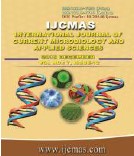


 National Academy of Agricultural Sciences (NAAS)
National Academy of Agricultural Sciences (NAAS)

|
PRINT ISSN : 2319-7692
Online ISSN : 2319-7706 Issues : 12 per year Publisher : Excellent Publishers Email : editorijcmas@gmail.com / submit@ijcmas.com Editor-in-chief: Dr.M.Prakash Index Copernicus ICV 2018: 95.39 NAAS RATING 2020: 5.38 |
Biodiversity is commonly used for the totality and variability of species, genes and the ecosystems. They occupy at three levels i.e generic, species and ecology. Recently the advancement in bioinformatics is mainly accelerated by the study of molecular events using data obtained by exhaustive experiments such as whole genome sequencing, functional annotation, expression analysis and some others. However, the complete value of molecular biological information cannot be realized until it is possible to correlate genetic information with native habitat, neurobiology, physiology, or with genealogical relationships of the species. At the same time, biodiversity informatics would greatly benefit from inter-compatibility with molecular-level databases. The massive development of biodiversity related information systems over the WWW (World Wide Web) has created much excitement in recent years. Biodiversity information can be considered the basic data on the occurrence and diversity of species (or indeed, any recognizable taxa), commonly in association with information regarding their distribution in space, time, or both. Such information may be in the form of retained specimens and associated information, for example as assembled in the natural history collections of museums and herbaria, or as observational records, for example either from formal faunal or floristic surveys undertaken by professional biologists and students, or as amateur and other planned or unplanned observations including those increasingly coming under the scope of citizen science. Providing online, coherent digital access to this vast collection of disparate primary data is a core. Biodiversity Informatics function that is at the heart of regional and global biodiversity data networks. There is a resonance between the needs of biodiversity science and the opportunities for globalization and interoperability provided by the internet. The main objective of the bioinformatics projects is to conserve the biodiversity and permit data interoperability and knowledge synthesis across wide arrays of local systems, and to embed them in global knowledge. This paper emphasizes the importance of bioinformatics in the conservation of biodiversity databases of scattered data for biotechnological and agricultural research.
 |
 |
 |
 |
 |